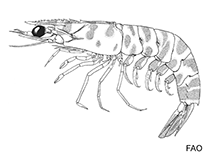Penaeus brevirostris Kingsley, 1878
Crystal shrimpGoogle image | No image available for this species;
drawing shows typical species in Penaeidae.
Classification / Names Tên thường gặp | Các synonym ( Các tên trùng) | CoL | ITIS | WoRMS
Malacostraca | Decapoda | Penaeidae
Environment: milieu / climate zone / Mức độ sâu / distribution range Sinh thái học
; Mức độ sâu 20 - 180 m (Tài liệu tham khảo 83922). Tropical, preferred 26°C (Tài liệu tham khảo 107945); 32°N - 5°S, 116°W - 77°W (Tài liệu tham khảo 75620)
Distribution Các nước | Các khu vực của FAO | Các hệ sinh thái | Những lần xuất hiện | Những chỉ dẫn
Pacific Ocean: Mexico to Peru and the Galapagos.
Length at first maturity / Bộ gần gũi / Weight / Age
Chín muồi sinh dục: Lm ? range ? - ? cm Max length : 15.0 cm TL con đực/không giới tính; (Tài liệu tham khảo 8); 17 cm TL (female)
Life cycle and mating behavior Chín muồi sinh dục | Sự tái sinh sản | Đẻ trứng | Eggs | Sự sinh sản | Larvae
Main reference
Các tài liệu tham khảo | Người điều phối | Người cộng tác
Holthuis, L.B. 1980 FAO Species Catalogue. Vol. 1. Shrimps and prawns of the world. An annotated catalogue of species of interest to fisheries. FAO Fish. Synop. 125(1):271 p. Rome: FAO. (Tài liệu tham khảo 8)
IUCN Red List Status
(Tài liệu tham khảo 130435: Version 2025-1)
CITES status (Tài liệu tham khảo 108899)
CMS (Tài liệu tham khảo 116361)
Threat to humans
Human uses
Các nghề cá: Tính thương mại
FAO - Các nghề cá: landings | FishSource | Biển chung quanh ta
Các công cụ
Thêm thông tin
Thành phần thức ăn
Thành phần thức ăn
Các động vật ăn mồi
Max. ages / sizes
Length-weight rel.
Length-length rel.
Length-frequencies
Mass conversion
Sự phong phú
Các nguồn internet
BHL | BOLD Systems | CISTI | DiscoverLife | FAO(Các nghề cá: ; publication : search) | Fishipedia | GenBank (genome, nucleotide) | GloBI | Gomexsi | Google Books | Google Scholar | Google | PubMed | Cây Đời sống | Wikipedia (Go, tìm) | Tạp chí Zoological Record



